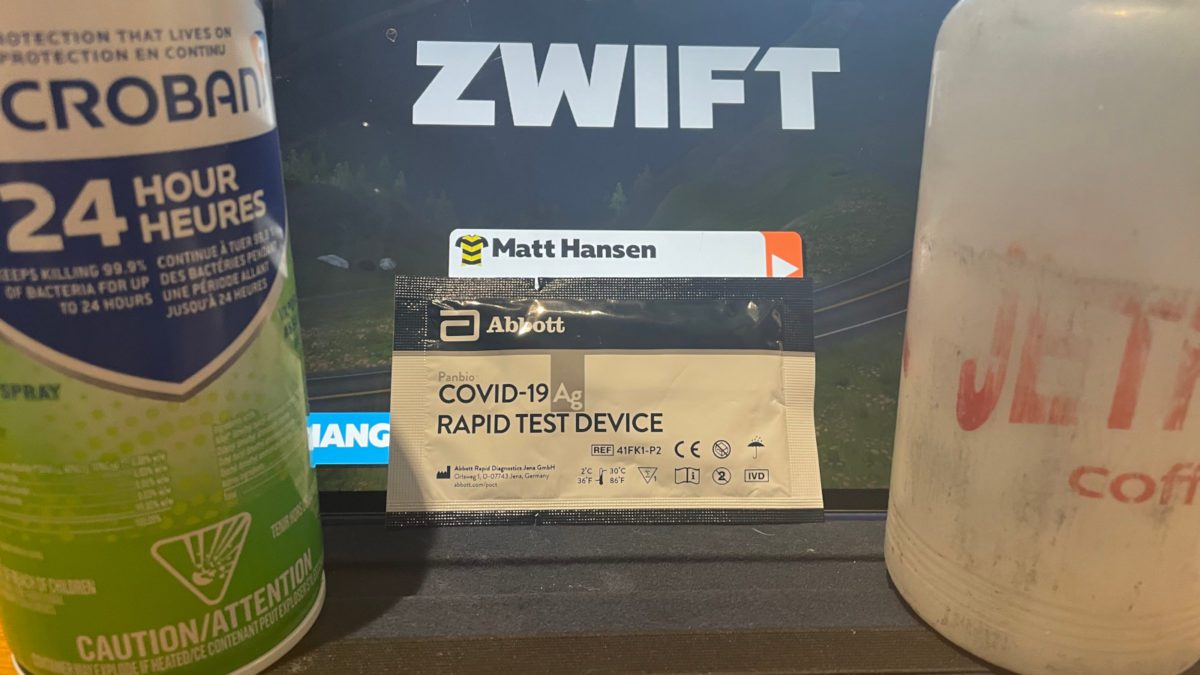This is what it’s like to train when you have COVID-19
It’s really not fun tbh
 Photo by:
I'll give you one guess
Photo by:
I'll give you one guess
Like so many people in Canada last week, I got the most famous bug on earth. And just like so many others in this whole thing, I’ve been careful, masking, and avoiding people. But it seems like the transmissibility of this Omicron variant is just too efficient. A few days before Christmas, I got sick. That meant not going to my parents, but I’m thankful I learned in time.
Like any cyclist, my first thought was, I can ride still, right? The first day or two wasn’t so bad: I just felt chills, and a sore throat. I talked to my GP who said no, do not ride for a few weeks.
I, of course, promptly ignored that advice. Once my fever went down, I climbed on the ole steed and flipped on Zwift.
At that point I had a bit of a cough, and basically felt like crap here and there. The weird thing about this thing is it’s really a sneaky bugger; every now and then you think you’re fine and then whammy! It’s back.
I rode for 30 minutes, super slow, and said, “This is really dumb,” and climbed off.
Training when sick
A general rule for traditional colds is “Exercise is usually OK if your symptoms are all ‘above the neck.’ These signs and symptoms include those you may have with a common cold, such as a runny nose, nasal congestion, sneezing or minor sore throat.”
Usually, most experts will say that when you are sick, but without a fever, you should, “Consider reducing the intensity and length of your workout.”
I was still feeling a bit weak and icky, but the following day I tried riding again, with very low intensity. To be honest, after the ride I felt better. My lungs sort of felt cleansed and I felt invigorated. I wasn’t as stuffed up, either. Plus, it gave me a reason to shower, something I hadn’t done in days.
That false sense of security lasted me to day five, when I made the brilliant decision to jump in a Zwift criterium, where I lasted exactly one minute. My lungs seared as I made efforts, and I quickly realized that I am not very bright. The whole day I felt like garbage, and had the equivalent of track hack and I couldn’t stop sneezing.
Most physicians also say “don’t exercise if your signs and symptoms are ‘below the neck,’ such as chest congestion, a hacking cough or upset stomach.” Which is something I should have considered, since at the time my cough was still dry and nasty.
It’s been a week now, and I still have a tiny lingering cough, but feel generally better. I’m still riding, but taking it easy and I’m pretty sure I wouldn’t be able to do many efforts without wrecking my throat and lungs again.
My medical advice
Sure, here it is: I HAVE NONE AS I AM NOT A DOCTOR. I do however, like so many of us, have a two year degree from Facebook University in epidemiology and infectious diseases.
Everyone will be different if/when they get COVID-19, even with Omicron. For all those saying it is mild, I think it’s up to you to define mild. I’m in pretty good shape but it wasn’t quite like any “cold” I’ve ever had (and I haven’t been sick for years.) The real zinger is how it comes and goes, unlike the traditional trajectory of a cold: you get sick, really sick, sickest, then it gradually goes away. This one comes and goes.
Either way, it’s always good to listen to your body no matter what kind of illness. Talk to your doctor, one who has a sports background is perhaps even more helpful. But erring on the side of caution is wise. Don’t ride hard as the efforts could prolong or exacerbate your illness.
